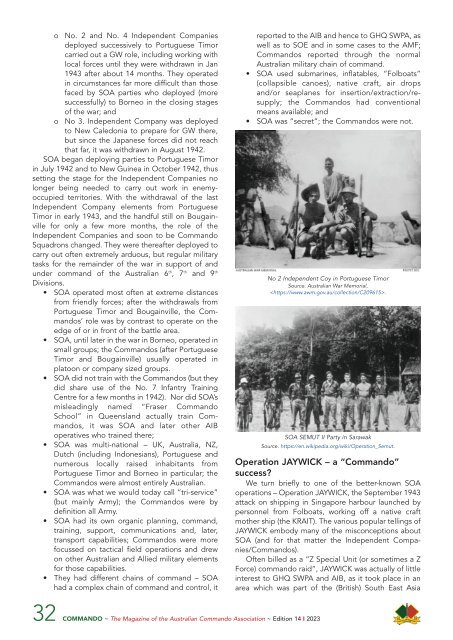Official Commando News Magazine edition 14 Mar 2023
You also want an ePaper? Increase the reach of your titles
YUMPU automatically turns print PDFs into web optimized ePapers that Google loves.
o No. 2 and No. 4 Independent Companies<br />
deployed successively to Portuguese Timor<br />
carried out a GW role, including working with<br />
local forces until they were withdrawn in Jan<br />
1943 after about <strong>14</strong> months. They operated<br />
in circumstances far more difficult than those<br />
faced by SOA parties who deployed (more<br />
successfully) to Borneo in the closing stages<br />
of the war; and<br />
o No 3. Independent Company was deployed<br />
to New Caledonia to prepare for GW there,<br />
but since the Japanese forces did not reach<br />
that far, it was withdrawn in August 1942.<br />
SOA began deploying parties to Portuguese Timor<br />
in July 1942 and to New Guinea in October 1942, thus<br />
setting the stage for the Independent Companies no<br />
longer being needed to carry out work in enemyoccupied<br />
territories. With the withdrawal of the last<br />
Independent Company elements from Portuguese<br />
Timor in early 1943, and the handful still on Bougain -<br />
ville for only a few more months, the role of the<br />
Independent Companies and soon to be <strong>Commando</strong><br />
Squadrons changed. They were thereafter deployed to<br />
carry out often extremely arduous, but regular military<br />
tasks for the remainder of the war in support of and<br />
under command of the Australian 6 th , 7 th and 9 th<br />
Divisions.<br />
• SOA operated most often at extreme distances<br />
from friendly forces; after the withdrawals from<br />
Portuguese Timor and Bougainville, the Com -<br />
mandos’ role was by contrast to operate on the<br />
edge of or in front of the battle area.<br />
• SOA, until later in the war in Borneo, operated in<br />
small groups; the <strong>Commando</strong>s (after Portuguese<br />
Timor and Bougainville) usually operated in<br />
platoon or company sized groups.<br />
• SOA did not train with the <strong>Commando</strong>s (but they<br />
did share use of the No. 7 Infantry Training<br />
Centre for a few months in 1942). Nor did SOA’s<br />
misleadingly named “Fraser <strong>Commando</strong><br />
School” in Queensland actually train Com -<br />
mandos, it was SOA and later other AIB<br />
operatives who trained there;<br />
• SOA was multi-national – UK, Australia, NZ,<br />
Dutch (including Indonesians), Portuguese and<br />
numerous locally raised inhabitants from<br />
Portuguese Timor and Borneo in particular; the<br />
<strong>Commando</strong>s were almost entirely Australian.<br />
• SOA was what we would today call “tri-service”<br />
(but mainly Army); the <strong>Commando</strong>s were by<br />
definition all Army.<br />
• SOA had its own organic planning, command,<br />
training, support, communications and, later,<br />
transport capabilities; <strong>Commando</strong>s were more<br />
focussed on tactical field operations and drew<br />
on other Australian and Allied military elements<br />
for those capabilities.<br />
• They had different chains of command – SOA<br />
had a complex chain of command and control, it<br />
reported to the AIB and hence to GHQ SWPA, as<br />
well as to SOE and in some cases to the AMF;<br />
<strong>Commando</strong>s reported through the normal<br />
Australian military chain of command.<br />
• SOA used submarines, inflatables, “Folboats”<br />
(collapsible canoes), native craft, air drops<br />
and/or seaplanes for insertion/extraction/re -<br />
supply; the <strong>Commando</strong>s had conventional<br />
means available; and<br />
• SOA was “secret”; the <strong>Commando</strong>s were not.<br />
No 2 Independent Coy in Portuguese Timor<br />
Source. Australian War Memorial,<br />
.<br />
SOA SEMUT II Party in Sarawak<br />
Source. https://en.wikipedia.org/wiki/Operation_Semut.<br />
Operation JAYWICK – a “<strong>Commando</strong>”<br />
success?<br />
We turn briefly to one of the better-known SOA<br />
operations – Operation JAYWICK, the September 1943<br />
attack on shipping in Singapore harbour launched by<br />
personnel from Folboats, working off a native craft<br />
mother ship (the KRAIT). The various popular tellings of<br />
JAYWICK embody many of the misconceptions about<br />
SOA (and for that matter the Independent Com pa -<br />
nies/<strong>Commando</strong>s).<br />
Often billed as a “Z Special Unit (or sometimes a Z<br />
Force) commando raid”, JAYWICK was actually of little<br />
interest to GHQ SWPA and AIB, as it took place in an<br />
area which was part of the (British) South East Asia<br />
32 COMMANDO ~ The <strong>Magazine</strong> of the Australian <strong>Commando</strong> Association ~ Edition <strong>14</strong> I <strong>2023</strong>
















